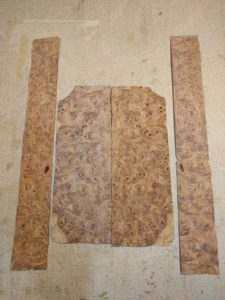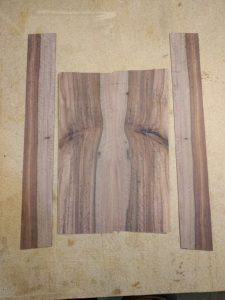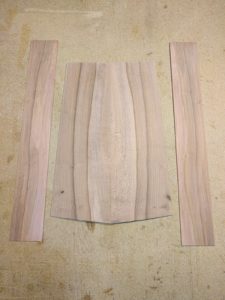To go with that nice curly redwood top wood, I have been picking out back and side wood for the next set of 4. I am interested in using local, sustainable, wood as much as possible. A while back I was talking to a fellow who sold guitar wood, with a particular emphasis on local north-eastern woods. He said that the best local tone wood was black locust. He also said that if you ask any builder what is the most important thing about a piece of wood, they will all say ‘the way it sounds’ but, he said, they buy it by the way it looks.
I have accumulated quite a bit of black locust in my wood stash, from some local sources. It is hard, resilient, and stiff, a good tonewood. The only problem is that is boring, a kind of olive yellow that never gets curly, birds-eye, wavy, or otherwise ‘interesting’. Great sounding wood that is under utilized because of the way it looks. To remedy this situation I have figured out how to apply a veneer to the locust. I have started to use the term ‘laminated’ since when the side is taken down to it final thickness, the veneer is 25% of the overall thickness. Using veneer I can put any sort of fancy wood on the outside of the ukulele for looks, and have the locust on the inside for the way it sounds. Veneer is a very sustainable way to use fancy tropical woods, since one can make a huge amount of veneer from a log that would yield only a few boards, and after all, it is really only the surface of the wood that we look at.
So, in the next set will be 2 locust ukes, with veneer. One with ziricote:
and one with amboyna burl (you could not build a solid wood burl ukulele)
I spend the winters in Florida, and there is an invasive tree that was planted all over south Florida called a Casuarina or Australian Pine (it is not a pine). The wood is very hard, dense, takes a wonderful polish, and rings nicely when you tap on it. As good or better than any rosewood I think. I managed to find some trees that had been taken down as part of a ecological restoration (it is after all, a foreign invasive species) and cut some billets. I have cut some of this up to make fingerboards (it is going to be an absolutely wonderful fingerboard material) and got a few pieces that are big enough for back and sides. So one of the next set is going to be a casuarina uke:
Finally, I am going to build another concert so I have one ‘in stock’. I going to use some dogwood from some big dogwoods that got taken down by the power company on the back of my property here in Pennsylvania (we grow big dogwood). Dogwood is very fine grained, hard, bends well and should make a nice instrument. This will be paired with a spruce top from a large spruce that came down in a storm a couple of miles from my house. A truly ‘local’ ukulele. It will also have a casuarina fingerboard and bridge, not local but harvesting invasive species.



